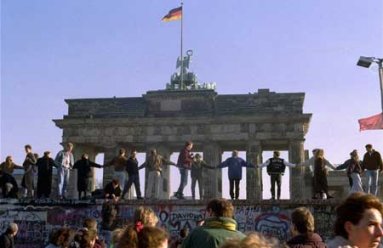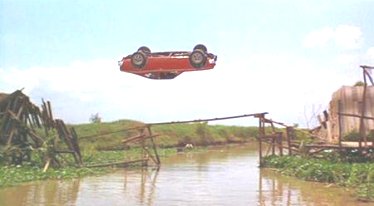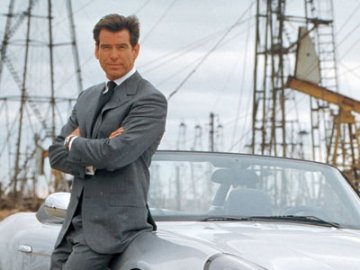|
The Quantum of Solace Freefall Sequence - An Analysis by Luke Quantrill

There are certain key events in world history so touchingly profound
that we all remember exactly where we were when they happened. The
historic fall of the Berlin Wall. Dirk Benedict finishing third in
Celebrity Big Brother. The invention of circular T-Bags. Even at such
short distance we can safely add the freefall sequence from the classic
James Bond picture Quantum of Solace. Here was Bond finally as Fleming
intended, flipping motorcycles over with a flick of the hand and
crashing through glass with a pudding bowl haircut. The freefall is
already a cherished part of Bond history and this magnificent piece of
filmmaking surely deserves closer inspection. Rex Beardsley, the
irrepressible and highly respected webmaster of JamesBondMadhouse.Net,
told me over the telephone recently why he regards this seminal moment
in Bondage to be so important. "You have to remember," said Rex. "That
Bond films used to be made to entertain people. They were trifling
indulgences. A yoghurt with some nuts sprinkled on top. An individual
fruit pie with a hint of nutmeg. The Bond films today are serious and
gritty, dare I say intellectual. The freefall is a postmodern
subtextual comment on the alienation of man in Western industrial
society. Bond is helpless, at the mercy of a new world where fortunes
are electronically won and lost before you've even finished your
Weetabix or found a pair of socks that match. Take Quantum of Solace.
The film looks like it was edited by a man having a funny turn on a
rollercoaster. But you notice how, at the end, when the credits roll,
the screen stays stock still at last? Bond has found clarity. He's
found his quantum of solace." I asked Rex to elaborate but he couldn't
remember what happened at the end of the film and his tea was getting
cold.

I sought to investigate further by placing the scene in a cogent
literary context. How does the Quantum of Solace freefall sequence tie
in with the James Bond created and written about by Ian Fleming? Is it
Flemingesque? Or Flemingologist? Are these even words? Zack Kojak, of
AgentBondIsABadass.Com, supplied some feedback. "We feel that Craig and
Connery are supreme and the rest are asswipes," offered Zack. "Because
Connery and Craig are so similar aren't they? They could be twins even.
Uncanny. The freefall scene works on at least 100 different levels.
Think about it. If you fall out of an aeroplane you'll probably fall
downwards. Eon got that exactly right, no one can deny that. Realism is
always the key. I counted at least a million unbelievable moments in
the Pierce Brosnan films but now we're back to the roots of the
character, what Ian Fleming described. Anyone who didn't like Quantum
of Solace obviously isn't intelligent enough to understand what Eon are
doing. They should read more Albert Camus." I left Zack complaining
about the whistle sound effect in The Man With the Golden Gun and
comparing Daniel Craig to Sir Laurence Olivier on his forums and
decided to search for a more scientific explanation as to why Quantum
of Solace and that freefall in particular constitute classic Bond.
Dr Vic Pasquale, a senior lecturer in Nuclear Physics and Gravity at
the University of Huddersfield, watched the sequence with me in his
office on campus. "Interesting," he said at the conclusion, reaching
for another polo mint. "Very interesting indeed. On the surface it
looks like a standard bauble of stuntery and optical effects for the
purpose of entertainment. To wit; a component of the visual dramatic
arts medium. This however would be a simplistic way to interpret said
images. The freefall sequence represents empirical discipline which in
turn implies existential crisis. It is a piece of art to rival those
incredible Apples and Pears by Cézanne. The science is 100%
accurate. Astonishing. I really believed that little chap had fallen
out of an aeroplane." I asked Dr Pasquale if he felt it was realistic
that Bond should land with nothing much in the way of serious injury.
"Interesting," he replied, reaching for a family sized packet of Fox's
Glacier Mints. "Very interesting indeed. It depends what he landed on
from a scientific standpoint. If it was a bouncy castle I think he may
have survived."

Pressing on undaunted, I made contact with Alan Petrocelli, a former
employee of Pinewood Studios who claims to have worked in the special
effects department during the production of Quantum of Solace. The
official story is that Alan only worked in the canteen and was fired
for stealing toilet paper and liquid soap but he denies this
vehemently. "The sequence took three months to complete," said Alan,
opening a flask of soup. "I can honestly tell you it brought tears to
our eyes when we saw it. It looked for all the world like Daniel was
flying through the air like a big muscle-bound pigeon." Alan spoke
warmly of his time at Eon and shared misty-eyed anecdotes detailing the
high spirited mischief that helped everyone through those long days and
nights. "Just before a scene once we gave Daniel a giant pair of
oversized sunglasses we'd bought at a seaside novelty shop. We told him
he looked really cool in them. If you watch the film you'll notice
several moments where Bond is posing in a pair of massive sunglasses,
thinking he looks cool but actually looking ridiculous. We had fun with
Brosnan too. Watch The World Is Not Enough carefully and you'll spot a
moment where Bond's drink has one of those twisty, luminous party
straws sticking out of it. Pierce was absolutely furious when he found
out."
In deep contemplation I watched the red streaks morphing into the sky
as the kettle boiled and a cat meowed while a man somewhere unwrapped a
humbug and the flickering lights of the ships on the horizon beckoned
like a buttered crumpet and a mug of cocoa. I still didn't quite
understand why the freefall sequence and Quantum of Solace were so
brilliant but I knew they were. I was fortunate to live in such
exciting times.
Next Month: Luke Quantrill
investigates the Quantum of Solace motorcycle flip. Why was it so
brilliant and what did it really mean?
c 2010
Alternative 007
|

|


